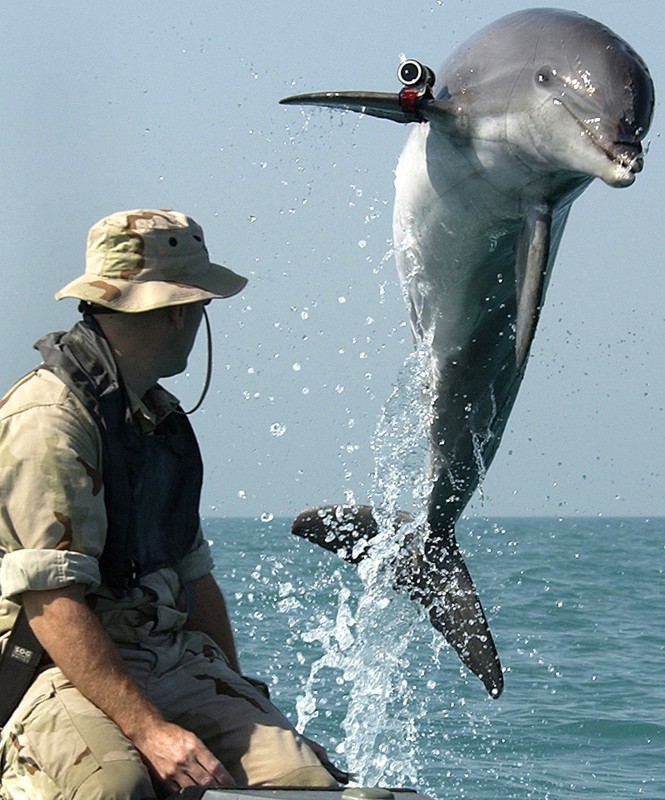 If Iran closes the Strait of Hormuz, the U.S. Navy has a backup plan to save one-fifth of the world’s daily oil trade: send in the dolphins.
If Iran closes the Strait of Hormuz, the U.S. Navy has a backup plan to save one-fifth of the world’s daily oil trade: send in the dolphins.
The threat of Iran closing the strait has reached a fever pitch, reports today’s New York Times, with U.S. officials warning Iran’s supreme leader that such moves would cross a “red line” provoking a U.S. response. Iran could block the strait with any assortment of mines, armed speed boats or anti-ship cruise missiles but according to Michael Connell at the Center for Naval Analysis, “The immediate issue [for the U.S. military] is to get the mines.” To solve that problem, the Navy has a solution that isn’t heavily-advertised but has a time-tested success rate: mine-detecting dolphins.
“We’ve got dolphins,” said retired Adm. Tim Keating in a Wednesday interview with NPR. Keating commanded the U.S. 5th Fleet in Bahrain during the run-up to the Iraq war. He sounded uncomfortable with elaborating on the Navy’s use of the lovable mammals but said in a situation like the standoff in Hormuz, Navy-trained dolphins would come in handy:
KEATING: They are astounding in their ability to detect underwater objects.
NPR’s TOM BOWMAN: Dolphins were sent to the Persian Gulf as part of the American invasion force in Iraq.
KEATING: I’d rather not talk about whether we used them or not. They were present in theater.
BOWMAN: But you can’t say whether you used them or not.
KEATING: I’d rather not.

The invasion of Iraq was the last time the minesweeping capability of dolphins was widely-touted. “Dolphins – – which possess sonar so keen they can discern a quarter from a dime when blindfolded and spot a 3-inch metal sphere from 370 feet away — are invaluable minesweepers,” reported The San Francisco Chronicle. In 2010, the Seattle Times reported that the Navy has 80 bottlenose dolphins in the San Diego Bay alone. They are taught to hunt for mines and drop acoustic transponders nearby. The photo above shows a dolphin with a tracking device attached to its fin. According to a report in 2003, the dolphins only detect the mines. Destroying them is left up to the Navy’s human divers. Still, the mammals are large enough to detonate a live mine, a prospect that doesn’t delight animal rights groups.
When this was an issue in 2003, lobbying for the rights of dolphins was much more politically sensitive given that scores of U.S. men and women were being sent into battle as well. “We’re not going to second-guess the Navy at a time of war,” said Naomi Rose, a marine mammal scientist with the Humane Society. “But we don’t support the use of marine mammals for military use.” According to the Chronicle, the two groups emphasized that “they were not placing the lives of animals above those of troops. But they questioned the ethics and wisdom of using wild animals to ensure safe passage through hostile waters.” Petitions have also been sent to the Defense Department protesting the use of dolphins:
[Since] forces regard the Navy dolphins as enemy dolphins, there might be attempts on the dolphins lives. There is also the risk of indiscriminate killing of wild dolphin populations because any dolphin can potentially be an enemy dolphin. Also, the inherent danger that a dolphin may be injured or killed in mine-hunting operations remains a very real threat.
Back in 2003, Tom LaPuzza, a spokesman for the San Diego-based Space and Naval Warfare Systems Center, cast aside the skepticism about how the dolphins were treated:
By nature, dolphins are naturally reliable and trustworthy animals who seem to enjoy pleasing their human handlers, LaPuzza said. When they are released into the ocean for missions, “they come back to the handler, the trainer” ashore or on a ship.
Leave a Reply
You must be logged in to post a comment.